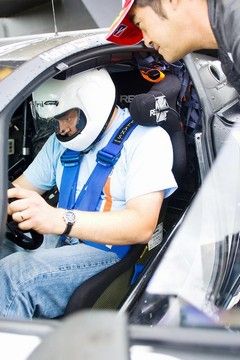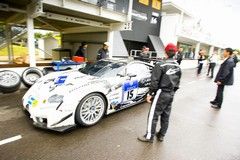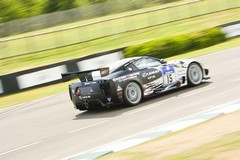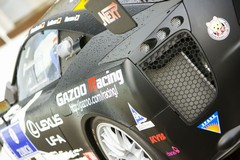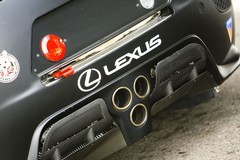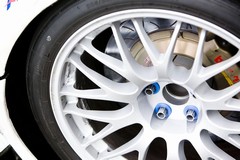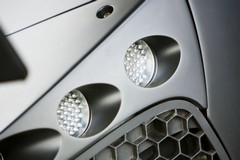Driven: Lexus LF-A 5.0 V10 Coupe
PH's Chris-R gets behind the wheel of Lexus's awesome £250k (yes, really) Ferrari rival
‘This could be interesting,’ I thought, as a crack team of Japanese race engineers tightened the webbing straps over my vital organs. ‘But more likely it’s just going to be terrifying…’
As first introductions to brand new supercars go, they don’t get much more intimidating than this. Being strapped into the racing version of the 500bhp+ V10-powered, carbonfibre-tubbed Lexus LF-A sports coupe, its nose pointing straight down the pitlane of the seriously fast and (hopefully!) flowing Goodwood race circuit that I’ve never driven before, and watching anxiously as the pit crew wipe raindrops off the car’s swoopy windscreen.
To be fair, the rain has stopped when the moment comes for my first three laps, but the track is still wet enough for earnest debate within the team as to whether wet tyres are most appropriate for the conditions. Reassuringly, I’m not invited to contribute to the conversation, and the decision to stay on slicks gives me a few more minutes to acclimatise to the pain in my pelvic bones caused by the vice-like grip of a far-too-small racing seat. So we wait for the hot sun to simmer more water off the tarmac, and for the visor of my helmet to start misting up properly...
Then the small crowd milling around the car thins out, and there’s somebody giving me a thumbs up. It’s time to go.
The LF-A racer’s starting ritual is straightforward enough; twist the electrical master-switch to ‘on’, turn the ignition key, then press the small red starter button on top of the dash. There’s a whirr from the starter, and the 5.0 V10 engine bursts gruffly into life. My momentary sense of relief disappears as the thumbs-up turns into an urgently waved hand. ‘Get out there now, you big wuss,’ the gesture seems to imply. So I nudge the right-hand paddle towards me to select first (which engages with a not-very-muted shudder, and accelerate the car tentatively up the pitlane.
Although the race car engine apparently revs to a heady 12,000rpm, today we’ve been asked to limit our exuberance, which means short-shifting at a still impressive 8500rpm – or rather less when in the vicinity of the Goodwood circuit’s electronic decibel monitors. The car’s engine hasn’t been stripped since its recent outing at the Nurburgring 24hr race, so the race team’s caution seems well advised. That said, we’ve been tipped-off that the imminent production version of the LF-A will be limited to 9000rpm, so we’re pretty close to experiencing the performance potential of the road car. And that potential, in spite of the unsettling conditions at Goodwood, felt genuinely phenomenal.
The racing car accelerates flat and hard with a typical V10 howl; harsher, more mechanical and somehow less mellifluous than a V12, but spine-tingling all the same. The effect is amplified by the racer’s stripped-out interior and race exhaust, but if the Lexus engineers can keep any of that sound for the road version, then its owners are in for a true aural treat.
The rate at which knots are piled on under full throttle is unsurprising, given the car’s all-up weight of just 1500kgs and a power output of ‘something over 500bhp’, which is all that Lexus will currently admit to. No performance figures or official outputs have been revealed, but when we had a look under the bonnet somebody had scrawled ‘#557 P’ with a marker pen on one of the cylinder head covers. Could this have been the record of an engine dyno test?
The engine looks compact and is presumably very light. There’s also quite a lot of room around it in the engine bay, where it sits well back to help optimise weight distribution. You can see the aluminium front sub-frame that’s bolted directly to the carbonfibre body tub, and there’s another at the rear to support the gearbox and rear running gear. The gearbox itself is a transaxle-mounted six-speeder shifted electronically by two steering column-mounted paddles (left for down, right for up - Nissan GT-R style), and gearchanges in the racer seem to alternate between utterly seamless and occasionally a little jerky, particularly in the lower ratios. Whether this has something to do with the racing set-up or even racing wear and tear I can’t tell you – but I wouldn’t expect to feel it in a production version of this car. Or any Lexus for that matter. Either way, the configuration allows a near-perfect weight distribution of 48/52 (front/rear), and remarkably well-balanced handling.
Although it very much looks the part in race trim, the LF-A competed in the production class at the Nurburgring, which means it’s not very far from the road car that Lexus is expected to reveal later this year at the Tokyo motor show. According to insiders, the weight of the racing gear (full roll cage, fire systems, huge steel brakes, etc.) is roughly equivalent to the weight of the road car items that have been removed – namely interior trim, proper seats, and info-tainment.
The racer’s suspension settings have been stiffened up a little for the track and it runs slick racing tyres (or grooved wets), which have the same 20-inch diameter as the road-going items will. The racer's steel brakes will be replaced with carbon-ceramic items, but most other components - including the carbon tub and alloy-skinned carbon body - will be carried over to the road car. What you see here is essentially what you’re going to get if you’ve got a spare £250k (yes, really!), and are prepared to move quickly to secure one of the 20 or so cars expected in the UK after production starts late this year. The total global production run is unlikely to exceed 500, we are reliably informed.
I have to admit that around Goodwood on its slick racing tyres, even on a drying track, I never got remotely close to exploring the limits of this stiff, light and extremely competent machine, but I can say it changed direction at speed like a slot car, with linear steering offering apparently instantaneous turn-in, with barely any of the car’s mass or weight transfer affecting its composure through corners. There was a chance for another three laps after lunch, but by then it had rained heavily, the track was soaked in places and, with the car running on grooved slick tyres, I could do little more than enjoy the pretence of playing at being a racing driver – albeit one going slowly.
Still, that’s not bad for an introduction to a car that seems perfectly likely to set the cat among the pigeons when the roadgoing version is finally released. With a power to weight ratio similar to a Ferrari 599's and with performance and handling right up there with the best, Lexus obviously feels it has got the German exec saloons covered and is now ready to take on the Italian stallions.
Gassing Station | General Gassing | Top of Page | What's New | My Stuff


